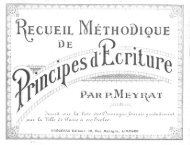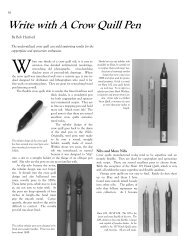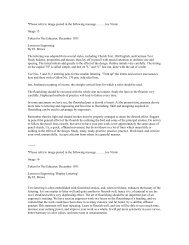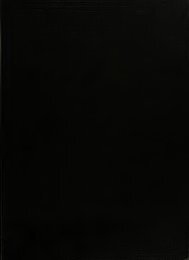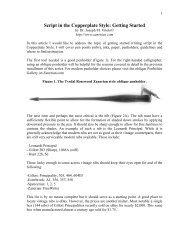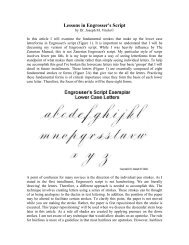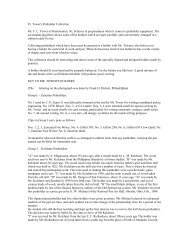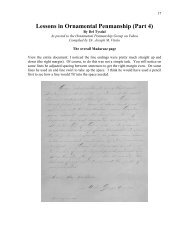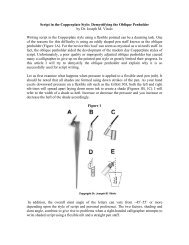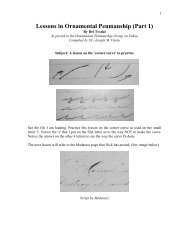The Educator (Volume 45) - IAMPETH
The Educator (Volume 45) - IAMPETH
The Educator (Volume 45) - IAMPETH
Create successful ePaper yourself
Turn your PDF publications into a flip-book with our unique Google optimized e-Paper software.
BOOK REVIEWS<br />
Our readers are interested in books of merit,<br />
but especially in books of interest and value to<br />
commercial teachers includinK books of special<br />
educational value and books on business subjects.<br />
All such books will be briefly reviewed<br />
in these columns, the object beinj? to give suffi-<br />
cient description of each to enable our readers<br />
to determine its value.<br />
Occupational Guidance for Youtli,<br />
Part No. 1, Finding Yourself, by F.<br />
Lyman Tibbitts, University of Oklahoma,<br />
Norman, Oklahoma. Published<br />
by <strong>The</strong> Hawlow Publishing Corporation,<br />
Oklahoma City, Oklahoma.<br />
(Paper cover, 29 pages.<br />
i Contents<br />
f<br />
of Part No. 1 :<br />
Introduction.<br />
Self-discovery.<br />
Occupational Life of the Community.<br />
Employment Probabilities.<br />
What Should One Know About Occupations.<br />
How to Study an Occupation Intelligently.<br />
Projects, Problems and References.<br />
A Girl Who Grows Up, by Ruth Fedder,<br />
Guidance Counselor, <strong>The</strong> Elkins<br />
Park Junior High School, Elkins<br />
Park, Pennsylvania. Published by<br />
the McGraw-Hill Book Company,<br />
New York, N. Y.<br />
Many volumes are at present available givng<br />
information to parents, teachers, or group<br />
eaders about problems of the teen-age girl.<br />
<strong>The</strong>re are few that have been written for the<br />
jiri herself. <strong>The</strong> author of this book is an<br />
ndividual who knows girls, because she has<br />
ived and worked with them. Miss Fedder<br />
ipeaks out of a very practical and tested<br />
experience with girls and a sound knowledge<br />
>f the psyrholnpy und< rlying the behaviour<br />
nanift'stations that puzzle a girl or her older<br />
"rit-nds in the process of her growing up.<br />
Some of the chapter heads are as follows:<br />
Iniwing Up. Gaining Self Confidence, Acting<br />
['our Age. Growing Up Emotionallv. Getting<br />
)n With People. Associating Happily With<br />
ioys. Deciding About a Job. <strong>The</strong> Give and<br />
i'akf of Living, Books You May Want To<br />
business Law for Everyday Use, by<br />
A. Lincoln Lavine, A.B., LL.B.,<br />
J.D., Professor of Law and Chairman<br />
of the Law Department, St.<br />
John's University, School of Commerce,<br />
Brooklyn, N. Y.; Member of<br />
the New York Bar, and Morris<br />
Mandel, M.B.A., Instructor in Business<br />
Law and Accounting, New<br />
Utrecht High School, Brooklyn, N.<br />
V. Published by <strong>The</strong> John C. Wins-<br />
ton Company, Philadelphia, Pa.<br />
Cloth cover, 612 pages.<br />
This new book is a practical text that<br />
rien tales for the high -school student a sublet<br />
of vital importance in everyday life. A<br />
)und knowledge of the fundamental princiles<br />
of business law is necessary, regardless<br />
f thf student's future course in school, busi-<br />
t'ss. tir industry. With an approach that is<br />
livr ;ind interesting, yet also pedagogically<br />
Tn-rt, BUSINESS LAW FOR EVERYDAY<br />
SP: piovides that knowledge.<br />
<strong>The</strong> <strong>Educator</strong> 29<br />
Built on the unit plan, each of the eighty<br />
units represents a discussion and an explanation<br />
of one definite thtme woven around a<br />
legal maxim. Generous use is made of the<br />
question-and-answer method, so frequently applied<br />
in law. Lists of highlights from the<br />
unit, legal terms, queries that test student<br />
understanding, and practical, original cases<br />
which interpret and apply the principle<br />
learned follow each unit. <strong>The</strong>se exercises<br />
stimulate the student's interest in the procedure<br />
of the law and challenge him to logical<br />
and just thinking.<br />
Teachers who prefer to present their subject<br />
by the "case method" alone will note<br />
that there are comprehensive lists of supplementary<br />
cases at the end of each chapter.<br />
<strong>The</strong>se lists also provide for individual differences.<br />
Students with a flair for business law<br />
will find here in these supplementary cases<br />
ample material to satisfy their demands. However,<br />
if so desired, the cases may be omitted.<br />
yet the contents will remain adequate for all<br />
students.<br />
<strong>The</strong> clear, simple style is well within the<br />
comprehension of every high-school student.<br />
It never becomes involved or too technical as<br />
is the case of many texts having law for<br />
their subject.<br />
Beautiful murals symbolic of the law. drawings<br />
which interpret legal principles, and reproductions<br />
of legal and business forms comprise<br />
the unusual illustrations. AJl have<br />
definite earning value and all are in accord<br />
with modern principles of visual education.<br />
<strong>The</strong> Medical Stenographer, by Effie<br />
B. Smither. Published by the<br />
Gregg Publishing Company, New<br />
York, N. Y. Cloth cover, 399 pages.<br />
This book was prepared for those who<br />
wish to learn to take medical dictation with<br />
facility and speed. A specialized training for<br />
shorthand writers who already are able to<br />
write Gregg Shorthand with ordinai->' speed.<br />
It was written by an author who was formerly<br />
the stenographer of a prominent physician.<br />
and contains ( 1 ) student instructions, 1 2<br />
medical word lists to preview the dictation.<br />
(3) medical case histories in shorthand, and<br />
(5) biographies of famous men in the field of<br />
medicine. <strong>The</strong> meaning of all medical terms<br />
is carefully brought out.<br />
Rhythmic I'ypewriting Drills, by<br />
Merla L. Reed. Published by <strong>The</strong><br />
Gregg Publishing Company, New<br />
York, N. Y. Paper cover, 42 pages.<br />
This is a supplementary typing text that<br />
contains the procedures and exercise material<br />
for developing metronomic and flowing rhythm<br />
along with the regular typing instruction. <strong>The</strong><br />
short lessons are accompanied by instructions<br />
to the student and an indication as to which<br />
of the Rational Rhythm Records can be used<br />
to the best advantage. Suitable for beginning<br />
or advanced students.<br />
Teach Your Fingers To Spell, by<br />
Bitha Craig and Louis A. Leslie.<br />
Published by <strong>The</strong> Gregg Publishing<br />
Company, New York, N. Y. Paper<br />
cover, 125 pages.<br />
This is a new method of teaching spellings<br />
by means of the typewriter. It is based on<br />
the fact that when the fingers of the typist<br />
are taught to spell they have a more tenacious<br />
memory than the mind. <strong>The</strong> exercises<br />
call for the student, first, to type a selected<br />
list of spelling words, and then to type a<br />
meaningful paragraph in which these words<br />
are used. While the major result is improved<br />
spelling ability, the student's typing speed and<br />
accuracy are improved as a by-product. <strong>The</strong><br />
book is spiral-bound permitting it to stand<br />
up on the desk like an opened typing book.<br />
)<br />
Business Education, Basic Principles<br />
and Trends, by Herbert A. Tonne.<br />
New York University, Published<br />
by <strong>The</strong> Gregg Publishing Company,<br />
New York, N. Y. Cloth cover,.<br />
344 pages.<br />
This book has been written to present an<br />
understanding of the fundamental aspects of<br />
business education. It may be used for a onest.me.ster<br />
course by giving briefer consideration<br />
to those topics deemed less important, or may<br />
be used as the basis for a two-semester course<br />
by more extensive use of the review questions<br />
and problems presented for discussion.<br />
<strong>The</strong> first part of the book deals with the<br />
place of business education in the secondary<br />
school in terms of its objectives. <strong>The</strong> second<br />
portion of the book is devoted to a consideration<br />
of specific training for business occupations<br />
in the secondary school and other types<br />
of schools giving work in business education.<br />
Sympathetic treatment is given to the development<br />
of business education for the consumer,<br />
distributive education, general and<br />
specialized office practice, the shift upward<br />
of vocational training, and other progressive<br />
attempts at improving the work of business<br />
education. However, the difficulties in the development<br />
of these suggestions are not minimized.<br />
<strong>The</strong> criticisms of the basic program<br />
of business education now in operation are<br />
given full recognition ; but the continuing<br />
efficiency and student value of the backbone<br />
subjects of business education are made completely<br />
evident.<br />
Vw enty Shortcuts to Shorthand<br />
Speed, by Clyde Insley Blanchard,<br />
Instructor in High-Speed Shorthand,<br />
Evening Sessions, Hunter<br />
College of the City of New York;<br />
Holder of Gregg Official 175-Word<br />
Medal; General Editor, <strong>The</strong> Gregg<br />
Publishing Company. Published by<br />
the Gregg Publishing Company,<br />
New York, N. Y. Cloth cover,.<br />
100 pages.<br />
This is an informal method book on shorthand<br />
teaching. Each of twenty fundamental<br />
shorthand teaching principles is discussed in<br />
an informal, detailed, and practical manner.<br />
<strong>The</strong> teaching procedures covered are those<br />
that occur and reoccur to the average teacher<br />
many times in a year of shorthand teaching.<br />
Beginning teachers and experienced teachers<br />
alike should find possibilities for professional<br />
improvement in this volume by an experienced<br />
shorthand teacher.<br />
I have been enjoying the <strong>Educator</strong><br />
greatly. You are to be congratulated<br />
on the varied, interesting articles<br />
published, and also on the splendid<br />
services rendered the penmanship<br />
profession through your valuable<br />
magazine.<br />
G. C. GREENE,<br />
Registiar and Vocational Adviser<br />
Banks College,<br />
Philadelphia, Pa.<br />
PENCRAFT STUDIO<br />
On December 15, Adjutant F. O.<br />
Anderson, Hibbing, Minnesota, opened<br />
up the Pencraft Studio. He reports<br />
that he has already started out with<br />
some worthwhile orders.<br />
Adjutant Anderson is a very skillful<br />
penman as most of our readers<br />
know. <strong>The</strong>re is plenty of pen work<br />
to do if one is qualified to do it.<br />
Adjutant Anderson will be glad to<br />
exchange specimens with other penmen<br />
and engiossers.



